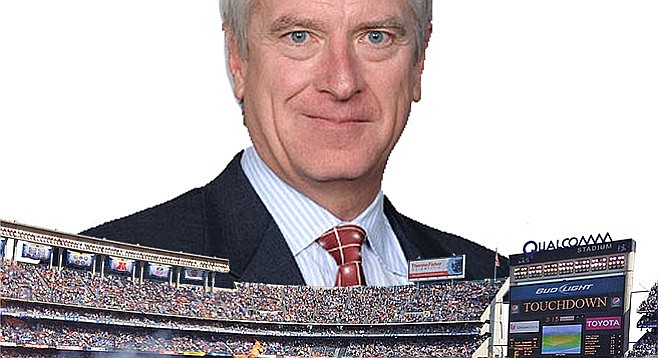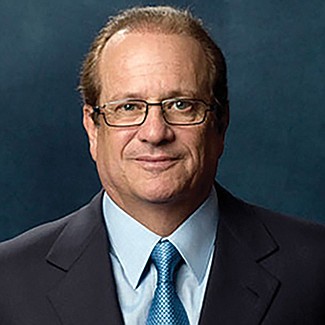 Facebook
Facebook
 X
X
 Instagram
Instagram
 TikTok
TikTok
 Youtube
Youtube

The plans for a new downtown Chargers stadium should come out Monday (March 28) or sometime during the week. Many of the purported details have been leaked to friendly media, so all San Diegans should be prepared to cock an eyebrow at this proposal. Here are some things to check carefully:
— The cost of the the so-called "convadium" (combined football stadium and convention center) is said to be $1.8 billion. But how can anybody put a price on this planned facility without having a good idea how much it will cost to move the San Diego Metropolitan Transit System bus yard at 16th and Imperial Avenue? The system says moving the facility may take five to seven years and will be very expensive. The cost — and the cost of the delay — must be taken into account. Construction costs of stadiums and convention centers have been rising steadily.
— Planners are apparently counting on the taxpayers to pick up the $200 million tab for land acquisition. Why should taxpayers pay for this? The Chargers should pay at least half of such costs.

— The planners are apparently counting on the sale of personal seat licenses to rake in money. Forget it. Mark Fabiani, Chargers mouthpiece, told me in 2011, "We do not anticipate selling [personal seat licenses] in any significant numbers in this marketplace." (Personal seat licenses are expensive, and give the buyer the right to certain seats for the season.) They were very successful for the 49ers' stadium in Santa Clara. But Santa Clara is in Silicon Valley, one of the nation's richest places. These licenses are sold in an aftermarket. And 49ers licenses are not doing so well in the aftermarket.
— Watch to see what the Chargers are expecting from the sale of luxury suites. They don't do well in San Diego for the same reason — moderate incomes and very high cost of living — that personal seat licenses are out of the question.
— Planners are expecting the transient occupancy (hotel) tax to rise to 16.5 percent, one of the handful of the highest in the nation. Convention planners take costs into account. Very closely. This high hotel tax will definitely dent convention attendance and hurt non-convention hotel visits throughout the year. Do the planners realize that the total hotel receipts will decline with a rate so high? Also, do the convention-center executives and hoteliers realize that having two centers separated by five or six blocks is only suitable for two separate conventions?
— Will convention visitors appreciate paying a 16.5 percent tax when there are so many homeless in the area?
— Convadium planners are flipping the bird at Comic-Con, the major convention-center event. Comic-Con has already come out in favor of a contiguous convention-center expansion. If San Diego leaders go ahead with a secondary center five to six blocks away, and voters okay it, San Diego is kissing Comic-Con goodbye. Do the planners realize this?
— The convadium planners should explain the $200 million loan from the National Football League. The media are saying the National Football League is chipping in with $300 million. This assumes the loan is in fact a grant. Is it? The convadium pushers must explain this. If it is a loan, what are the terms?
— How much will naming rights bring in? The mayor's task force planning a Mission Valley stadium estimated that 20-year naming rights would bring in $135 million to $165 million. What are the planners counting on for a downtown stadium?
— Arts groups such as the opera and symphony get money from the hotel tax. Will they get the same amount, or more, than they have been receiving? Or will they be shortchanged? If arts groups get cut back, the economy will feel it, because almost all those on arts payrolls spend their money locally.

— After naming rights, advertising rights, and the like are subtracted from the so-called Chargers' contribution, is there anything left? Is the Spanos family planning to get this for almost nothing?
— Finally, it is time for the Chargers to reveal whether they have an option to go to Los Angeles — an option the Spanos family can afford. When the Chargers lost out on their bid for L.A. and came back to San Diego claiming that they had an L.A. option but had decided they loved San Diego, few San Diegans swallowed such a tale. With public support for the downtown stadium very low, it is time for Dean Spanos to admit to the public that the so-called L.A. option was just a scare tactic.


The plans for a new downtown Chargers stadium should come out Monday (March 28) or sometime during the week. Many of the purported details have been leaked to friendly media, so all San Diegans should be prepared to cock an eyebrow at this proposal. Here are some things to check carefully:
— The cost of the the so-called "convadium" (combined football stadium and convention center) is said to be $1.8 billion. But how can anybody put a price on this planned facility without having a good idea how much it will cost to move the San Diego Metropolitan Transit System bus yard at 16th and Imperial Avenue? The system says moving the facility may take five to seven years and will be very expensive. The cost — and the cost of the delay — must be taken into account. Construction costs of stadiums and convention centers have been rising steadily.
— Planners are apparently counting on the taxpayers to pick up the $200 million tab for land acquisition. Why should taxpayers pay for this? The Chargers should pay at least half of such costs.

— The planners are apparently counting on the sale of personal seat licenses to rake in money. Forget it. Mark Fabiani, Chargers mouthpiece, told me in 2011, "We do not anticipate selling [personal seat licenses] in any significant numbers in this marketplace." (Personal seat licenses are expensive, and give the buyer the right to certain seats for the season.) They were very successful for the 49ers' stadium in Santa Clara. But Santa Clara is in Silicon Valley, one of the nation's richest places. These licenses are sold in an aftermarket. And 49ers licenses are not doing so well in the aftermarket.
— Watch to see what the Chargers are expecting from the sale of luxury suites. They don't do well in San Diego for the same reason — moderate incomes and very high cost of living — that personal seat licenses are out of the question.
— Planners are expecting the transient occupancy (hotel) tax to rise to 16.5 percent, one of the handful of the highest in the nation. Convention planners take costs into account. Very closely. This high hotel tax will definitely dent convention attendance and hurt non-convention hotel visits throughout the year. Do the planners realize that the total hotel receipts will decline with a rate so high? Also, do the convention-center executives and hoteliers realize that having two centers separated by five or six blocks is only suitable for two separate conventions?
— Will convention visitors appreciate paying a 16.5 percent tax when there are so many homeless in the area?
— Convadium planners are flipping the bird at Comic-Con, the major convention-center event. Comic-Con has already come out in favor of a contiguous convention-center expansion. If San Diego leaders go ahead with a secondary center five to six blocks away, and voters okay it, San Diego is kissing Comic-Con goodbye. Do the planners realize this?
— The convadium planners should explain the $200 million loan from the National Football League. The media are saying the National Football League is chipping in with $300 million. This assumes the loan is in fact a grant. Is it? The convadium pushers must explain this. If it is a loan, what are the terms?
— How much will naming rights bring in? The mayor's task force planning a Mission Valley stadium estimated that 20-year naming rights would bring in $135 million to $165 million. What are the planners counting on for a downtown stadium?
— Arts groups such as the opera and symphony get money from the hotel tax. Will they get the same amount, or more, than they have been receiving? Or will they be shortchanged? If arts groups get cut back, the economy will feel it, because almost all those on arts payrolls spend their money locally.

— After naming rights, advertising rights, and the like are subtracted from the so-called Chargers' contribution, is there anything left? Is the Spanos family planning to get this for almost nothing?
— Finally, it is time for the Chargers to reveal whether they have an option to go to Los Angeles — an option the Spanos family can afford. When the Chargers lost out on their bid for L.A. and came back to San Diego claiming that they had an L.A. option but had decided they loved San Diego, few San Diegans swallowed such a tale. With public support for the downtown stadium very low, it is time for Dean Spanos to admit to the public that the so-called L.A. option was just a scare tactic.
Comments